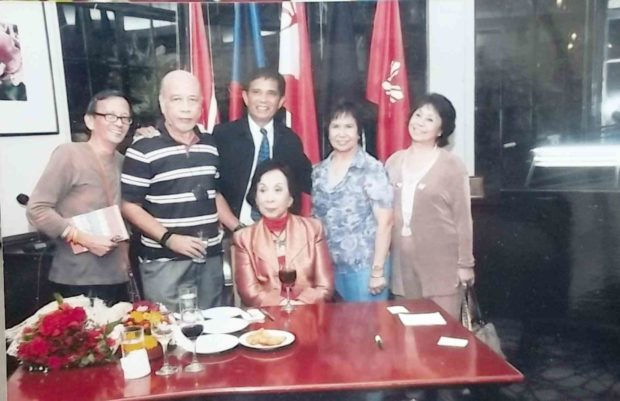
In the fourth generation of Guerreros, preceding mine, there were three superstars: Leon Ma. Guerrero, diplomat, biographer of Rizal, translator of “Noli” and “Fili”;
Wilfrido Ma. Guerrero, playwright, pioneer of English drama in the Philippines, and mentor to many who would become well-known directors and actors; and Carmen Guerrero Nakpil, essayist, historian and journalist.
Carmen was Tita Chitang to her multitude of nephews, nieces and younger friends and just Chitang to all and sundry, whether friend or foe.
An honor student, she studied at St. Theresa’s College in San Marcelino, Manila, which she fondly described as “that Belgian concentration camp.” She married the “handsomest Atenean” Ysmael Cruz, one of those unsung heroes of the war, who was murdered by the Japanese. The war traumatized Carmen, her hair turned white overnight, and for many years she did not speak or write about the horror.
After the war she became a journalist, thanks to Don Ramon Roces, and was later courted by architect Angel Nakpil, soft-spoken, another handsome gentleman of the old school. “Father, I’m going to marry Nakpil,” she blurted out before a bemused Fr. Horacio de la Costa, SJ. “I’m tired of my name Carmen Guerrero Cruz which makes me sound like a Mexican bombshell!”
Father De la Costa, ever the historian, responded: “Hmm, Nakpil. That’s a Tagalog surname. The collaborationists or the native elite—these were the only ones allowed by the Spaniards to retain their native names.”
Of course the Nakpils were native elite. They were ilustrado who aligned themselves with Bonifacio against Aguinaldo. As composer Jerry A. Dadap, my choirmaster, would say: Had Bonifacio won the struggle, the patriotic anthem we are now rehearsing (by Julio Nakpil) would be the national anthem and not “Lupang Hinirang.”
Carmen gave her first husband two children: Gemma and Ysmael Cruz II; and three children for her second husband— (the late) Ramon, Lizza and Luis Nakpil.
How to deal with US
She once wrote that she was the ugly duckling of the family when she was a child, which is hard to believe because she grew up to be a tall beauty (although not as tall as daughter Gemma). And as one writer (Kerima Polotan) observed, she had beautiful legs.
Speaking of Polotan, during the early 1960s in the segregated United States South, she was mistaken for a mulata and denied service in a restaurant. Furious, she returned the travel allowance to the US State Department. “You don’t do that,” Tita Chitang gently chided her. “With the Americans you take the money and run!”
Her fashion sense I leave to the fashion writers, but she always dressed well and with care. And even those who didn’t like her conceded that she was “elegant.”
My aunt read widely, fiction, history, politics, biography, arts and letters. The New Yorker was one of her favorite magazines and she read the Latin-American novelists like Gabriel Garcia Marquez in the original Spanish. Once she opined that fiction was for the “starry eyed” but this did not prevent her from writing a novel, “The Rice Conspiracy,” which was, well, not her best work.
The essay was her forte, personal, historical or critical, and she was at her best and most sensitive when writing about her growing up years in Ermita. Her columns were also much discussed and she wrote for the old Manila Chronicle, Sunday Times Magazine, Graphic, and Malaya. She wrote many books, from “Woman Enough” (1963) to “Heroes and Villains (2010).
Her masterwork, however, was the trilogy of memoirs: “Myself, Elsewhere,” “Legends and Adventures” and “Exeunt.” Critics showered superlatives upon her books, citing her wit, style and command of English.
Martial law
When martial law was imposed by the dictator Marcos in 1972, my colleagues at the Graphic magazine were being hunted and arrested. My aunt advised me to go into hiding as “there might be a second wave of arrests.” But, as it turned out, no one was looking for me. “We had a dossier on you but we did not arrest you because you were not important enough,” a high school classmate and later general said.
My Aunt Chitang was at first critical of martial law but later supported Marcos. They were, after all, friends and neighbors in San Juan. And when her brother Leon lay dying in the hospital, thin and emaciated, Marcos personally went there and awarded the ambassador for his heroism and service to the country.
“I would have invited you,” my aunt said. “But I know how you feel about Marcos.”
At the end, however, in one of her memoirs, there was thinly criticism of the Marcoses, for being out of touch with reality as People Power Edsa I approached.
In her final years, another stroke felled her. She could not see, hear or speak well so she just stayed at home, with a caregiver nearby and her children taking turns visiting her daily. And she went back to Spanish, the language of her youth, the language handed down to us by our parents and grandparents.
So when she could talk, she would only do so in Spanish. When Gemma was there everything was fine. But once she had to go abroad and Lizza sent out a call to me and another cousin, Nonon Padilla, to “come here and speak in Spanish to mom.”
Finally she went gentle into the night, into the Light. Her children called her wake at the Heritage Memorial Park “a celebration of life.” She was interred in Loyola Memorial Park last Thursday, Aug. 2.
In her final book of memoirs my Aunt Chitang took comfort in the lines of St. Teresa of Avila: “Nada te turbe. Nada te espante. Let nothing disturb or frighten you. No longer restless or fractured, rid at last of all strange gods, this very old heart withdraws into peace. It’s really time to go. One should know when to die.” –CONTRIBUTED